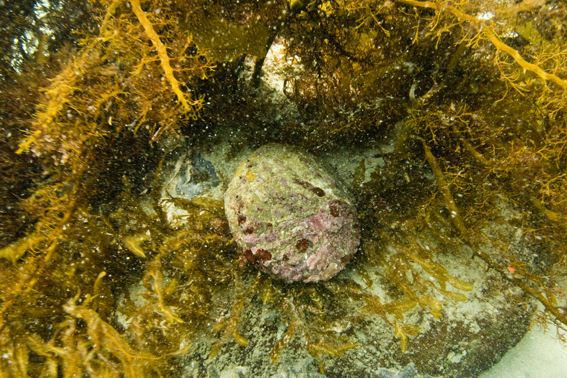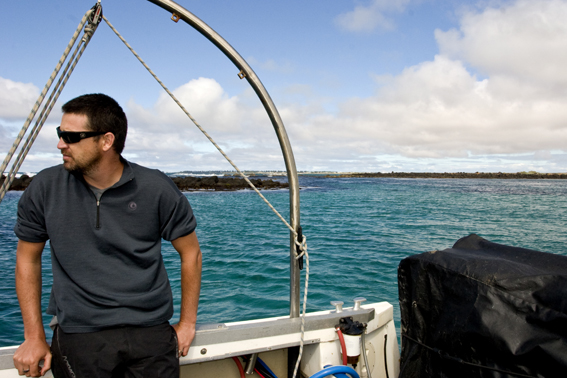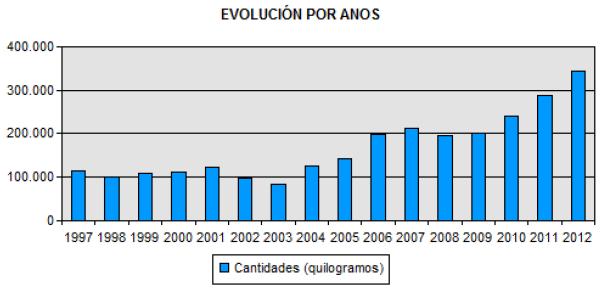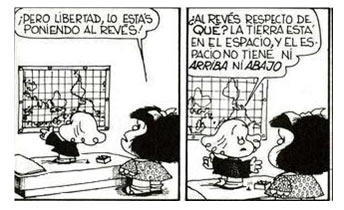
Me despierto sobresaltado por un ruido infernal, algo así como si una grulla con graves problemas mentales se hubiera tragado uno de aquellos primeros módems externos. Tardo bastante en darme cuenta de donde estoy y de por qué me siento tan terriblemente cansado.
Después de uno de los viajes más largos que uno puede sufrir en avión, Jeremy Prince y Adrian Hordyk me han recogido en Melbourne para conducir durante otras 4 horas hasta Port Fairy. Un paseo para ellos en esta enorme isla donde los desplazamientos no se miden en km, sino en horas de conducción. Port Fairy está en la costa del estado de Victoria, al Sur de Australia. El sitio donde estar, según el lema del estado.
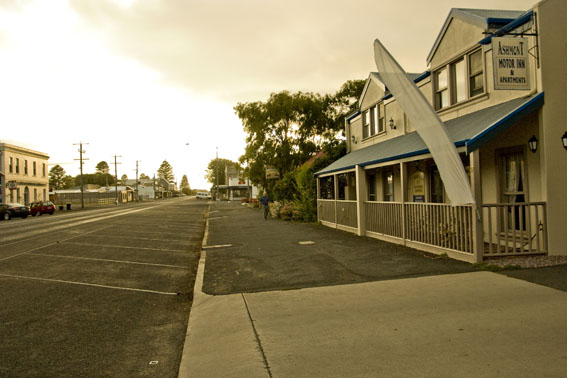
Port Fairy, al Sur de Australia, al amanecer.
Miro por la ventana del apartamento para tratar de identificar el origen del escándalo. No ha amanecido aún, pero la escasa luz que se filtra por las ventanas me permite vislumbrar a un pájaro blanco y negro, del tamaño y apariencia aproximada de un cuervo. El maldito bicho se debe de creer un ruiseñor y persiste, ggrrrrrrrrrrrrr-uiiiiiiiiiiiiiiiiii-prrriiiiiiiiiii. Estoy tentado de abrir la ventana y lanzarle un zapato, pero hasta donde yo se podría tratarse del último ejemplar de una especie única y no quiero provocar un incidente internacional.
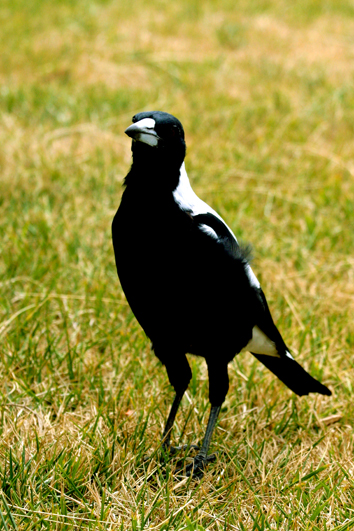
Un megpie. Una de las aves más abundantes y ruidosas de Australia.
Jeremy y Adrian me recogen para ir a desayunar, nos sentamos en la terraza de una coqueta cafetería del centro de Port Fairy, una de las localidades más antiguas de Australia. En el transcurso del corto paseo hasta la cafetería contabilizo un total de 7 pajarracos más, mirándome de manera descarada. No son tan escasos, pienso para mí, recordando el zapato.
Jeremy está dirigiendo la tesis de Adrian desarrollando un nuevo método de evaluación de pesquerías, simple y de bajo coste. Algo que puede suponer una revolución para la actual gestión de las pesquerías. Especialmente para las pequeñas, que no pueden permitirse las carísimas evaluaciones tradicionales. Planeamos la jornada mientras me peleo con una porción de tarta que podría alimentar a una familia durante un mes. Nos reuniremos con Peter Ridle, un buceador local que le ha pedido a Jeremy que le eche un vistazo a sus arrecifes de abalones. Después nos reuniremos con el resto de los buceadores de abalones del Oeste de Victoria (WADA) y biólogos del Ministerio de Pesca. Los buceadores tratarán de consensuar una postura única de cara a la importante reunión de mañana. Mañana se la juegan. Deberán llegar a un acuerdo con el Ministerio respecto de sus cuotas de pesca para el año que viene. Si no lo alcanzan, el Ministerio hará prevalecer su propio criterio.
Jeremy es profesor de biología en la Universidad de Perth, en el Oeste de Australia. Además es consultor ambiental especializado en la gestión de pesquerías. Pero estoy seguro de que Peter lo respeta más porque también es pescador de abalones desde hace años. De hecho acaba de pasar un mes con su familia en Nueva Zelanda, donde posee una cuota de recolección. Jeremy ha desarrollado una herramienta visual de evaluación del estado de las poblaciones de abalones basada en su propia experiencia como buceador y en el conocimiento experto de otros buceadores.
Los más de 500 cv del barco de Peter nos hacen volar sobre las olas y en poco tiempo alcanzamos los arrecifes que Jeremy va a evaluar. Cuando termina es mi turno. El agua tiene un aguamarina intenso y no está fría. Mi única preocupación son los tiburones blancos. No es que abunden, pero en esta zona se capturó el mayor tiburón blanco de la historia de Australia.
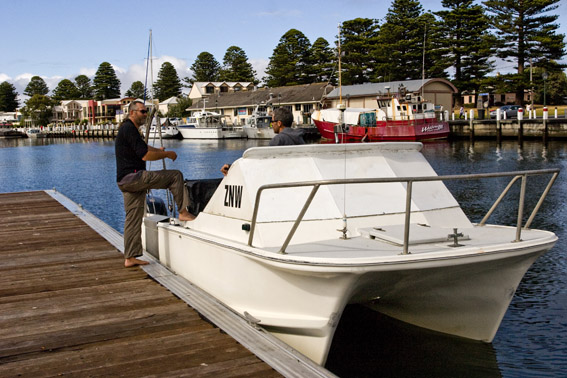
Jeremy y Peter, conversando en el muelle de Port Fairy.
Bucearé con suministro de aire superficie, así que mi rango de acción se verá muy limitado por la longitud de la manguera. Antes de arrojarme sobre la borda miro alrededor de reojo, buscando una aleta en la superficie. Me zambullo. –Toc-toc, ¿hay alguien en casa?
Peter me ha pedido que le suba tres abalones grandes. Jeremy subió algunos hace un rato, pero no cree que vayan a ser suficientes. Quiere que los pruebe para ver que me parecen. El lastre del chaleco que me ha prestado Peter no me permite más que reptar por el fondo, pero logro hacerme una idea de cómo es el ambiente de los arrecifes en el que viven los abalones. No es tan distinto de las familiares aguas de Galicia, excepto por los tiburones, claro. Capturo los tres moluscos y subo al barco.
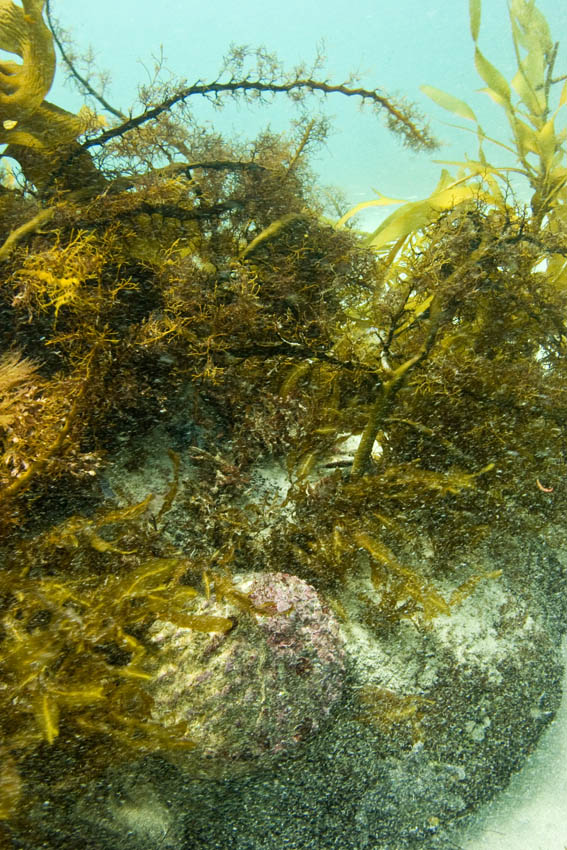
Un abalón (Haliotis sp.) en la costa de Port Fairy, Australia.
De vuelta en tierra, Peter cocina los abalones en su bonita casa, muy cerca del mar. Salteados con ajo, perejil y aceite. Previamente los golpea con una maza de madera para que estén tiernos. Tres veces. Ni una más ni una menos. Su sabor, un tanto vago, me recuerda al de la sepia. Después de todo los dos son moluscos. Pero en el mercado asiático valen su peso en oro, así que el total de la producción comercial se destina a la exportación. Sólo las escasas capturas realizadas por los buceadores recreativos se quedan en Australia.
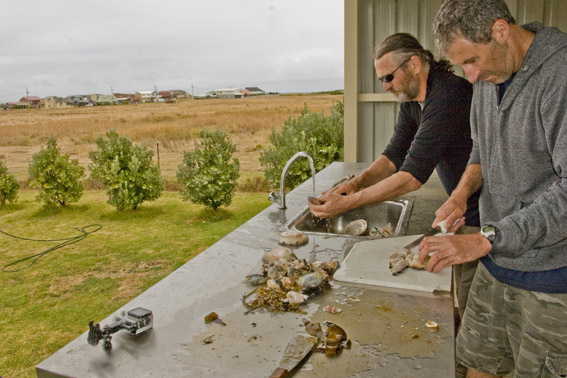
Peter, en primer término y Jeremy, preparando los abalones.
Durante la sobremesa me entero de que la pesca de abalones en Australia comenzó en la década de los 60 del pasado siglo. En los 80 resultó claro que los abalones estaban desapareciendo, así que se instauró un sistema basado en cuotas individuales. A cada asociación de buceadores se le ofreció la explotación exclusiva de los arrecifes de su área, a cambio de que gestionaran el recurso de forma sostenible. Y lo hicieron. Sobre todo los buceadores de la WADA. Hasta que apareció el virus.
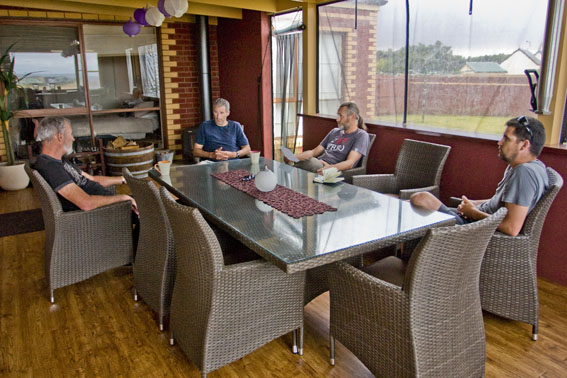
De derecha a izquierda, Adrian, Jeremy y Peter, charlando con otro miembro de la WADA.
En el año 2007 un criador informó de que los abalones de sus tanques se estaban muriendo de una enfermedad que literalmente los convertía en un grumo mucoso. Al poco tiempo ya estaba en el agua. Avanzó como un incendio forestal, devastando todo a su paso. Su tasa de mortalidad era de casi el 100%. Los buceadores estaban atónitos, a los tres días después del paso del frente de infección en el arrecife solo quedaban conchas llenas de mocos. El horror más absoluto. La corriente se llevaba los grumos cargados de virus e infectaba los arrecifes próximos.
Se trata de un tipo de herpes. Pero los herpes no matan a los organismos que infectan. Coevolucionan con ellos para maximizar su poder de infección. Si no matas a tu hospedador, tienes más posibilidades de infectar a otros. Jeremy especula con que el virus que infectó a los abalones saltó de otra especie. Y ni el virus ni los abalones estaban preparados para ello. El virus desapareció a los tres años, pero se llevó por delante a casi todos los abalones del Sur de Australia. Sólo algunos arrecifes se salvaron del desastre, sobre todo aquellos situados en zonas expuestas, donde los restos de los abalones muertos no quedaban retenidos.
Se tomaron medidas de control y se decretó el cierre de los arrecifes contaminados. En los arrecifes de la WADA se capturaban antes del virus 300 toneladas anuales de abalones. En 2012 se capturaron 40 toneladas. Ahora los buceadores creen que es el momento de subir las cuotas hasta un total de 70 toneladas. Además proponen flexibilizar el reparto de cuotas entre los arrecifes de manera que el esfuerzo de pesca pueda repartirse según las decisiones de los buceadores. Mañana se la juegan en la reunión con los delegados del Ministerio de Pesca.





